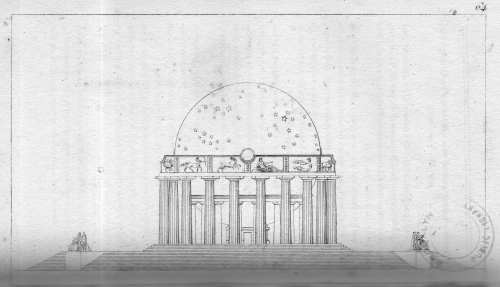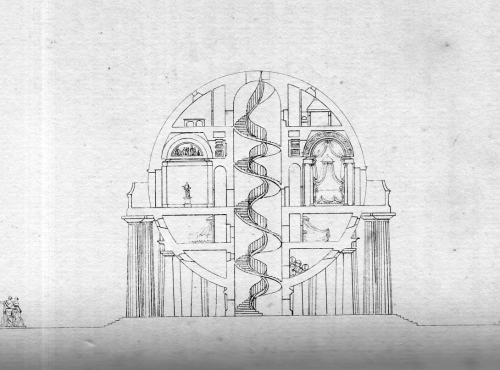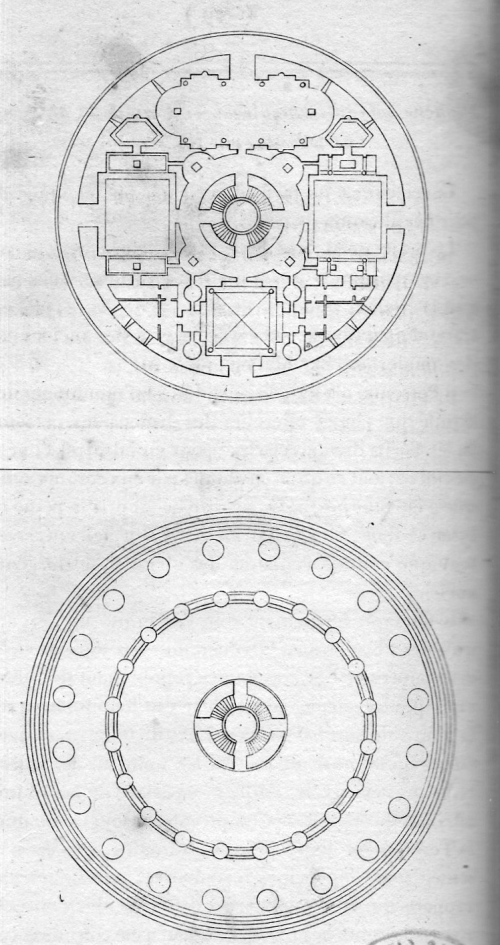JF Ptak Science Books Quick Post
Evidently M. Vaudoyer was a very early proponent of the spherical house, though (at least outside of architectural circles) his name is not nearly well known as Etienne Boulle, though perhaps if there was a movie1 constantly invoking a godlike reverence to his name he might be better known. The images below come from his time in Rome at the French Academy, and are his designs for a "maison d'un cosmopolite"--it was a grand home and a temple it seems rolled into one unit, a celebration of design and universal knowledge displayed in the sense of the world, the building itself a globe with a girdle of constellations. Boullee was very slightly earlier it seems (1784 compared to Vaudoyer's not-yet-published pen-and-ink drawings of 1785), and bigger, and in general just far more grand, with his Cenotaph for Newton, which was an impressive (and massive at 500' tall) and spectacular designs. In any event Vaudoyer was certainly encompassing a real visionary sense of architecture, which was an impressive thing to see here at the end of the 18th century.
[Vaudoyer engravings all from C.P. Landon, Annales du Musee, volume 2, 1815.]
Here's a bit on Vaudoyer from The Oxford Dictionary of Architecture (2015):
"Vaudoyer, Antoine-Laurent-Thomas (1756–1846) French architect, pupil of A.-F.Peyre, his early unexecuted designs demonstrated a concern for stereometrical purity that was a feature of late-C18 French Neo-Classicism, perhaps influenced by Boullée and anticipating works by Ledoux. With L.-P.Baltard and J.-D.Leroy he founded (1793) a School of Architecture that became the École des Beaux-Arts. He was an influential teacher, and began (1838) the conversion of the Priory of St-Martin-des-Champs, Paris, into theConservatoire des Arts et Métiers. With Baltard et al. he published designs for the Grands Prix (1806–34), and he himself published much."--The Oxford Dictionary of Architecture, 3rd edition, edited by James Curl and Susan Wilson.
Notes:
1. Peter Greenaway's very pretty if not occasionally trying Belly of an Architect, with music by Wim Mertens, which is worth the price of admission all on its own.
A small sketch study in pencil, ink and wash, dating from the elder Vaudoyer's time at the French Academy in Rome, for his 'maison d'un cosmopolite': a vision of a domestic temple to universal knowledge that began to circolate widely in print and drawn form from 1785 and was ingrained in the architectural discourse for much of the early 19th century.
Tandoyer's was the best known and perhaps earliest of many late Enlightenment speculations on spherical dwellings and memorials that might capture an entire cosmos of natural BCience. Vaudoyer lays astronomical and astrological features on its outer surfaces, and organises the interior spaces to capture not just the range of human knowledge, but the varieties of mood, sense and feeling that mark our universal condition.






Comments